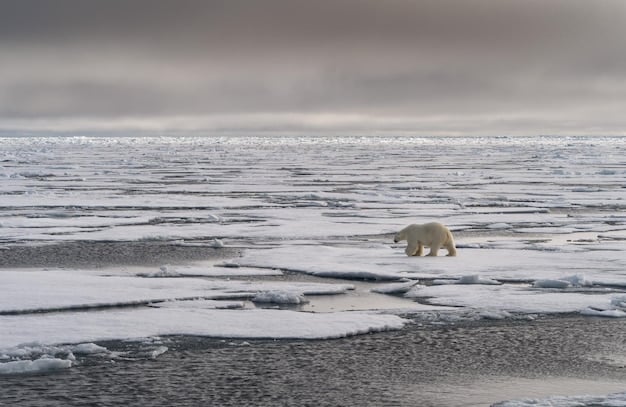The Cost of Inaction: Climate Goals 2030 Impact

Failing to meet The Cost of Inaction: What Will Happen if We Don’t Meet Our Climate Goals by 2030? will accelerate extreme weather, displace populations, disrupt economies, and irreversibly damage ecosystems, necessitating urgent global action to prevent catastrophic consequences.
The year 2030 stands as a critical benchmark in global climate action. It is often cited as a make-or-break deadline, a point by which significant strides must be made to avert the most catastrophic impacts of climate change. So, what exactly is The Cost of Inaction: What Will Happen if We Don’t Meet Our Climate Goals by 2030? The answer is complex, multifaceted, and deeply concerning, spanning environmental, economic, and social domains.
The urgency of the 2030 climate goals
The 2030 climate goals are not arbitrary numbers pulled from thin air; they are scientifically derived targets based on the latest climate models and assessments from bodies like the Intergovernmental Panel on Climate Change (IPCC). These goals primarily revolve around substantial reductions in global greenhouse gas emissions, aiming to limit global warming to well below 2 degrees Celsius above pre-industrial levels, and ideally to 1.5 degrees Celsius.
The 1.5-degree target is particularly crucial because even half a degree of warming beyond that threshold significantly increases the risks of severe, widespread, and irreversible impacts. Every fraction of a degree matters, intensifying extreme weather events, accelerating sea-level rise, and disrupting delicate ecosystems. The short timeframe to 2030 reflects the reality that cumulative emissions dictate future warming; the longer we wait, the harder and more expensive it becomes to mitigate the damage. This urgency is what drives the global push for rapid decarbonization and sustainable development.
Defining the 2030 targets
The 2030 targets typically call for a reduction in global net human-caused carbon dioxide emissions by about 45% from 2010 levels. This ambitious goal requires a fundamental transformation of energy systems, industrial processes, transportation, and land use worldwide. It means scaling up renewable energy technologies, enhancing energy efficiency, developing carbon capture solutions, and protecting and restoring natural carbon sinks like forests and peatlands.
- Accelerated decarbonization: A rapid shift from fossil fuels to renewable energy sources like solar and wind power.
- Energy efficiency improvements: Reducing energy consumption across all sectors, from building design to industrial processes.
- Sustainable land management: Protecting forests, restoring wetlands, and promoting sustainable agriculture to enhance carbon sequestration.
- Technological innovation: Investing in and deploying new technologies for emissions reduction and carbon removal.
Failing to achieve these specific reductions by 2030 does not mean global warming stops; rather, it solidifies a trajectory toward higher warming scenarios. These scenarios carry increasingly dire consequences, making adaptation exponentially more challenging and expensive. The targets serve as a clear directive for immediate and collective action. Without meeting them, the window for effective climate action narrows considerably, pushing us closer to irreversible tipping points.
The 2030 deadline is not merely a political or economic one; it is an ecological imperative. Scientists have repeatedly warned that exceeding certain thresholds leads to feedback loops that can amplify warming, such as the melting of permafrost releasing methane, or the reduced ability of oceans to absorb carbon dioxide. Therefore, the 2030 goals represent humanity’s last significant chance to establish a safer, more stable climate future.
Escalating extreme weather events
One of the most immediate and tangible consequences of failing to meet our 2030 climate goals will be a rapid acceleration and intensification of extreme weather events. We are already witnessing an increase in the frequency and severity of heatwaves, droughts, floods, and storms. Without aggressive emissions reductions, these events will not only become more common but also more destructive, far surpassing current patterns.
The planet’s weather systems are complex and interconnected, but they are also highly sensitive to changes in global temperatures. A warmer atmosphere holds more moisture, leading to more intense rainfall and flooding in some regions, while exacerbating droughts in others by increasing evaporation. Higher ocean temperatures fuel more powerful hurricanes and typhoons, extending their reach and devastating coastal communities.
Heatwaves and droughts
Expect more frequent, longer, and more intense heatwaves. These extreme heat events pose significant health risks, particularly for vulnerable populations, leading to heatstroke, cardiovascular strain, and increased mortality. They also dry out landscapes, creating conditions ripe for devastating wildfires, which in turn release more carbon, feeding a dangerous feedback loop. Agricultural yields would plummet due to water scarcity and heat stress, threatening global food security.
Droughts, already a major challenge in many parts of the world, would become more widespread and prolonged. This would severely impact water resources for drinking, sanitation, and hydropower, leading to increased competition and potential conflict over dwindling supplies. Ecosystems would suffer irreparable damage, with widespread extinctions of species unable to adapt to these rapidly changing conditions.

The economic toll from these events would be staggering. Infrastructure, from roads and bridges to power grids, is not designed to withstand such extreme conditions. Repairs and rebuilding efforts would divert massive resources that could otherwise be invested in sustainable development or adaptation measures. Insurance markets could even collapse in areas repeatedly hit by climate disasters, leaving communities vulnerable and financially ruined.
Beyond the direct physical and economic damage, there are profound social implications. Displacement of populations due to uninhabitable conditions, increased migration, and heightened social tensions can create instability on a global scale. The cumulative impact of these escalating extreme weather events would push human and natural systems beyond their adaptive capacities, leading to widespread disruption and suffering that dwarfs current challenges.
Global economic disruption and instability
The direct and indirect economic costs of climate inaction beyond 2030 would be immense, far exceeding the investment required for aggressive mitigation today. Climate change acts as a “threat multiplier,” exacerbating existing economic vulnerabilities and creating new ones across all sectors. Failing to meet emissions targets means subjecting the global economy to chronic shocks, reduced productivity, and increased systemic risk, ultimately impacting livelihoods and financial stability worldwide.
Consider the agricultural sector. Heat stress, altered precipitation patterns, and increased pest outbreaks will drastically reduce crop yields and livestock productivity. This will lead to food shortages, price volatility, and increased food insecurity, particularly in developing nations already facing challenges. Fishing industries will suffer from ocean warming and acidification, impacting marine biodiversity and coastal economies.
Supply chain vulnerabilities
Global supply chains are intricately linked and highly susceptible to disruption. Extreme weather events like floods, droughts, and severe storms can cripple transportation networks, damage production facilities, and disrupt the flow of goods and services. A single major climate event in a key manufacturing or shipping hub can create ripple effects that reverberate across the globe, leading to delays, shortages, and increased costs for consumers and businesses alike. This vulnerability will only intensify without climate action.
- Resource scarcity: Increased competition for dwindling water, arable land, and other natural resources.
- Infrastructure damage: Billions required for repairs and upgrades to withstand extreme weather, diverting funds from productive investments.
- Insurance market collapse: Rising claims from climate disasters could make insurance unaffordable or unavailable in high-risk areas.
- Diminished labor productivity: Extreme heat reduces outdoor work capacity and overall health, impacting economic output.
The financial sector is also at profound risk. Climate-related physical risks threaten property values, real estate markets, and loan portfolios. Transition risks, while necessary for decarbonization, also pose financial challenges for industries heavily reliant on fossil fuels. Without meeting 2030 goals, these risks intensify, potentially triggering cascading failures across financial institutions and markets, similar to a systemic financial crisis.
Furthermore, increased climate migration due to uninhabitable regions and resource scarcity will put immense pressure on public services, housing, and labor markets in host communities. Managing these massive population shifts requires significant financial resources and can strain social cohesion. The cumulative effect of these economic disruptions means less capital for innovation, education, and poverty reduction, locking the world into a cycle of reactive crisis management rather than proactive development.
Irreversible ecological damage and biodiversity loss
Beyond the tangible economic and social impacts, failing to meet our 2030 climate goals will accelerate an already alarming rate of ecological degradation and biodiversity loss. Ecosystems are finely balanced natural systems, and even small shifts in global temperature can have profound and cascading effects, pushing many species toward extinction and permanently altering the planet’s natural heritage. This constitutes an irreversible loss, as extinct species cannot be brought back, and complex ecosystems take millennia to form.
Consider the polar regions. The accelerated melting of ice sheets and glaciers will not only contribute to sea-level rise but also disrupt unique polar ecosystems, threatening iconic species like polar bears and seals. The loss of reflective ice also reduces the Earth’s albedo, meaning more solar radiation is absorbed, further accelerating global warming—a dangerous feedback loop.
Ocean acidification and coral bleaching
Oceans absorb a significant portion of the excess carbon dioxide in the atmosphere, a process that leads to ocean acidification. This chemical change makes it harder for marine organisms like corals, shellfish, and plankton to form their shells and skeletons, disrupting the base of the marine food web. Coral reefs, often called the “rainforests of the sea,” are particularly vulnerable to both ocean acidification and rising temperatures, leading to widespread coral bleaching events.
- Mass extinctions: Loss of species unable to adapt to rapid environmental changes, leading to ecosystem collapse.
- Ecosystem collapse: Disruption of complex food webs and ecological services essential for human well-being.
- Forest dieback: Increased temperatures and altered precipitation patterns leading to widespread tree mortality.
- Loss of natural carbon sinks: Degradation of forests, oceans, and wetlands reduces their capacity to absorb CO2.
The consequences extend to terrestrial ecosystems as well. Forests, vital carbon sinks and biodiversity hotspots, face increased threats from more frequent and intense wildfires, prolonged droughts, and new pest outbreaks. The Amazon rainforest, a critical global regulator of climate and biodiversity, is dangerously close to its tipping point, potentially transforming into a savanna-like ecosystem, releasing vast amounts of stored carbon and eradicating countless species.

The loss of biodiversity impacts humans directly. Ecosystems provide invaluable services, from clean air and water to pollination for crops and natural flood regulation. When these systems degrade, the cost of replacing these services or living without them becomes astronomical. Furthermore, the loss of genetic diversity weakens the resilience of natural systems to future shocks, making them even more vulnerable. This irreversible ecological damage represents a profound ethical and existential crisis, diminishing the planet’s life-support systems for future generations.
Humanitarian crises and mass displacement
The cascading effects of climate change, particularly if 2030 goals are unmet, will inevitably lead to an escalation of humanitarian crises and unprecedented levels of mass displacement. As parts of the world become increasingly uninhabitable due to extreme heat, water scarcity, rising sea levels, and agricultural collapse, millions will be forced to leave their homes in search of safety, resources, and viable livelihoods. This will place immense strain on global governance, aid organizations, and national infrastructures.
Coastal communities are on the front lines of sea-level rise. Even conservative projections indicate that without significant emissions cuts, many low-lying islands, delta regions, and coastal cities will be submerged or rendered unlivable by recurrent flooding. This will trigger large-scale internal and cross-border migration, creating “climate refugees” who lack formal recognition and protection under international law, complicating their resettlement and integration.
Food and water insecurity
Climate change profoundly impacts food and water security. Erratic rainfall, prolonged droughts, and increased temperatures directly threaten agricultural productivity. Regions heavily reliant on rain-fed agriculture will become increasingly vulnerable to crop failures, leading to widespread hunger and malnutrition. Water sources, already stressed in many parts of the world, will become scarcer, intensifying competition and potential conflicts over this vital resource.
Areas experiencing chronic food and water shortages are ripe for social unrest and conflict. Resource scarcity can exacerbate existing tensions, leading to violence over shrinking arable land or dwindling water supplies. This instability can further displace populations, creating a vicious cycle of crisis and migration. The humanitarian aid infrastructure, already stretched thin, would be overwhelmed by the sheer scale of the emergency.
Beyond these direct impacts, the psychological toll of climate change-induced displacement and loss is profound. The trauma of leaving one’s home, community, and livelihood behind, coupled with the uncertainties of resettlement, leads to increased rates of mental health issues, social dislocation, and intergenerational trauma. Children are particularly vulnerable, losing access to education and safe environments, trapping them in cycles of poverty and vulnerability.
The international community’s capacity and willingness to manage such large-scale humanitarian crises and mass displacement will be severely tested. Without proactive planning and significant investment in adaptation and resilience, the world could face multiple simultaneous crises, stretching resources and humanitarian aid to breaking point. The failure to meet 2030 climate goals means condemning millions to a future of instability, insecurity, and profound human suffering.
Threats to global security and geopolitical stability
Failing to meet 2030 climate goals will not only instigate humanitarian crises but also profoundly impact global security and geopolitical stability. Climate change acts as an accelerant of instability, intensifying existing conflicts and generating new ones by exacerbating resource scarcity, driving mass migration, and creating new strategic vulnerabilities. The interconnectedness of global systems means that climate-induced instability in one region can quickly spill over, affecting security worldwide.
Regions already prone to political fragility and social unrest will become even more volatile. Dwindling water resources, for instance, can reignite ancient disputes between nations or internal factions, particularly in arid and semi-arid zones. Crop failures and food price spikes can trigger riots and protests, leading to government instability and potential civil unrest. The breakdown of rule of law in climate-stressed areas creates fertile ground for extremist groups and criminal networks to flourish.
Increased competition for resources
As vital resources like freshwater and arable land become scarcer due to climate change, competition for these resources will intensify. This competition can occur at local, national, and international levels. Countries may resort to protectionist measures to secure their own food and water supplies, leading to trade disputes and diplomatic tensions. The Arctic region, made more accessible by melting ice, is already becoming a new frontier for resource extraction and strategic competition among global powers, risking militarization.
- Climate refugees: Increased pressure on borders and resources in host countries, leading to social friction.
- Destabilized governments: Climate impacts overwhelming state capacity, fostering extremism and unrest.
- Cross-border conflicts: Disputes over shared water sources or fertile land escalating into armed conflict.
- New maritime claims: Melting ice opening new shipping routes and exposing new resource deposits, leading to territorial disputes.
The phenomenon of climate migration will present an immense challenge to international relations. Large-scale movements of people can strain receiving countries’ social cohesion and economic capacity, potentially leading to xenophobia and political extremism. Border management systems will be overwhelmed, complicating efforts to provide humanitarian aid and maintain internal security. The lack of clear international frameworks for climate refugees means many will remain in precarious legal and social limbo, creating a vulnerable underclass.
Furthermore, military forces globally are grappling with the implications of climate change on their operations, infrastructure, and strategic priorities. Naval bases face sea-level rise, training grounds are impacted by extreme heat, and humanitarian missions respond to increasing climate disasters. This diversion of resources and attention from traditional security threats means a less prepared global security apparatus, increasing overall vulnerability. The failure to curb emissions by 2030 thus does not just lead to environmental degradation; it systematically erodes the foundations of global peace and security, ushering in an era of chronic instability and heightened geopolitical risk.
Technological and societal adaptation challenges
Even if global efforts were to dramatically increase beyond 2030, the failure to meet the near-term climate goals would introduce unprecedented technological and societal adaptation challenges. The sheer scale and speed of climate impacts would outpace our current capacity to adapt, leading to reactive measures that are often more expensive, less effective, and carry significant social burdens. Adaptation is always necessary, but its feasibility and success diminish with every degree of warming.
Developing and deploying robust adaptation technologies, such as advanced sea defenses, drought-resistant crops, and enhanced early warning systems, requires significant investment, research, and time. If climate impacts accelerate beyond current projections, these technologies may not be ready or scalable enough to protect vulnerable communities. Furthermore, many adaptation solutions have physical limits; no amount of sea wall construction can protect a city if sea-level rise renders it entirely submerged.
Social and economic equity
The burden of adaptation will fall disproportionately on the most vulnerable communities and nations, those with the fewest resources to prepare and respond. Wealthier nations might be able to afford significant infrastructure projects or technological fixes, but developing countries, which have contributed the least to historical emissions, will face insurmountable challenges. This exacerbates existing inequalities and can deepen poverty, creating vast climate injustice.
- Limited resources: Developing nations lack funding for necessary adaptation infrastructure and technologies.
- Maladaptation risks: Implementing solutions that inadvertently worsen conditions or have negative side effects.
- Loss of cultural heritage: Disappearing land and changing environments threaten Indigenous communities and historical sites.
- Mental health strain: Chronic anxiety and trauma from living with constant climate threats.
Societal adaptation involves more than just technological fixes; it requires fundamental shifts in human behavior, urban planning, and governance. Relocation of entire communities, for example, is a deeply complex and emotionally charged process that can lead to loss of cultural identity, social disruption, and psychological trauma. Changing agricultural practices due to prolonged droughts necessitates new knowledge, land management techniques, and potentially different crop choices, disrupting long-standing traditions and livelihoods.
Moreover, without meeting 2030 mitigation goals, the world risks crossing “tipping points”—thresholds beyond which certain climate impacts become irreversible and self-perpetuating. Examples include the collapse of major ice sheets, leading to meters of sea-level rise over centuries, or the widespread dieback of the Amazon rainforest. Once these tipping points are crossed, adaptation becomes not just challenging, but largely futile for those specific impacts. The scale of the threat demands a global, coordinated, and equitable approach to both mitigation and adaptation, where failing on the former dramatically amplifies the challenges of the latter.
The increasing unlikelihood of reaching 1.5°c target
The 1.5°C target, enshrined in the Paris Agreement, represents the ambition to limit global warming to a level that science suggests would avoid the most catastrophic and irreversible impacts of climate change. Failing to meet the 2030 climate goals critically diminishes the already narrow window to achieve this target, pushing it from a challenging but feasible ambition to an increasingly remote and possibly unattainable dream. This has profound implications for the future of the planet and humanity.
Every year of postponed action, every ton of emissions that goes unchecked, makes the 1.5°C target harder to achieve. The carbon budget – the total amount of carbon dioxide we can still emit while limiting warming to 1.5°C – is rapidly shrinking. If emissions continue at or near current rates beyond 2030, we will effectively “burn through” this budget, committing the planet to higher levels of warming. This means that a 2.0°C or even higher warming trajectory becomes the more likely outcome, with all the associated severe consequences discussed previously.
Consequences of exceeding 1.5°C
Exceeding the 1.5°C target, even temporarily, has cascading effects. While some impacts might be reversible over very long timescales, many are not. For example, the loss of coral reefs, which are critical marine ecosystems, becomes far more widespread and potentially permanent above 1.5°C. Increased frequency of extreme heat events, more intense droughts, and greater sea-level rise are all amplified with each additional fraction of a degree of warming.
- Irreversible damage: Crossing climate tipping points such as permafrost melt and ice sheet collapse.
- Increased adaptation costs: Exponentially higher financial and social burdens to cope with more severe impacts.
- Loss of ecosystems: Widespread species extinctions and degradation of natural systems.
- Reduced human well-being: Greater incidence of disease, malnutrition, displacement, and conflict globally.
The difference between 1.5°C and 2.0°C of warming might seem small, but it implies vastly different futures. The IPCC’s special report on 1.5°C highlighted these disparities: significantly more extreme heat days, longer hot spells, greater sea-level rise, and more pronounced impacts on biodiversity and food production at 2.0°C compared to 1.5°C. Missing the 2030 goals means locking in these more severe outcomes, making large-scale “overshoot” of the 1.5°C target almost certain.
Achieving net-zero emissions globally by mid-century would require extraordinary, unprecedented efforts if 2030 targets are missed. It would involve reliance on speculative and unproven large-scale carbon dioxide removal technologies, which present their own ethical and ecological challenges. The failure to act decisively by 2030 means passing on a far more dangerous and unstable planet to future generations, reducing their options for a livable future and increasing their vulnerability to forces beyond their control. Therefore, the 2030 deadline is not merely a political aspiration but a critical threshold for maintaining a semblance of climate stability.
The path forward: mitigation and adaptation
While the prospect of failing to meet 2030 climate goals presents a daunting picture, it is crucial to understand that inaction is a choice, and there are still pathways to mitigate the worst outcomes and adapt to unavoidable changes. The path forward demands a dual strategy: aggressive, rapid emissions reduction (mitigation) alongside robust efforts to build resilience and cope with existing and future climate impacts (adaptation). These two approaches are complementary and interdependent; without substantial mitigation, adaptation becomes increasingly difficult and costly.
Mitigation efforts must be scaled rapidly across all sectors. This means accelerating the transition to renewable energy sources, electrifying transportation, optimizing energy efficiency in buildings and industries, and implementing sustainable agricultural practices. Policies encouraging innovation, carbon pricing, and international cooperation are vital to drive this systemic transformation. It also requires phasing out fossil fuel subsidies and redirecting investments towards green technologies and infrastructure. This is not just an environmental imperative but an economic opportunity, fostering new industries and creating green jobs.
Building resilience and adaptation strategies
Simultaneously, societies must invest heavily in adaptation strategies. This includes developing climate-resilient infrastructure (e.g., elevated roads, resilient housing, flood defenses), implementing nature-based solutions (e.g., restoring coastal mangroves as storm buffers, afforestation for flood control), and improving early warning systems for extreme weather events. Enhancing drought-resistant crop varieties, investing in sustainable water management, and developing urban cooling centers are also critical steps. Adaptation must be locally tailored, recognizing diverse geographies and vulnerabilities.
- Accelerated renewable energy deployment: Massive investment in solar, wind, and other clean energy technologies.
- Carbon capture and storage: Developing and scaling technologies to remove CO2 from the atmosphere.
- Climate-resilient infrastructure: Designing and building structures that can withstand future climate extremes.
- Community-based adaptation: Empowering local communities to develop and implement tailored solutions.
Equitable climate action is paramount. Wealthier nations, historically responsible for the bulk of emissions, must provide financial and technological support to developing countries to enable their mitigation and adaptation efforts. This includes fulfilling climate finance pledges, facilitating technology transfer, and building capacity in vulnerable regions. Without global solidarity and justice, coordinated action against a global threat like climate change will be severely hampered. International agreements and frameworks, such as the Paris Agreement, provide the structure for this collective effort, but their effectiveness hinges on strong political will and sustained commitment from all signatories.
The period beyond 2030 will be defined by the choices made today. While the consequences of inaction are severe, the potential for effective action still exists. By prioritizing ambitious mitigation efforts and integrating robust adaptation strategies across all levels of society, there is still a chance to steer away from the most catastrophic climate scenarios. The path forward requires a fundamental societal shift, rooted in science, equity, and a shared vision for a sustainable future.
| Key Point | Brief Description |
|---|---|
| 🔥 Extreme Weather | Failure to meet 2030 goals means more intense heatwaves, droughts, floods, and superstorms. |
| 📉 Economic Instability | Disruptions to supply chains, agriculture, and infrastructure costing trillions, risking global recessions. |
| 🌍 Ecological Collapse | Irreversible biodiversity loss, ocean acidification, and degradation of vital ecosystems. |
| 🚶♀️ Mass Displacement | Millions forced from homes due to rising seas, water scarcity, and uninhabitable conditions, creating humanitarian crises. |
Frequently asked questions
▼
2030 is critical because it’s the deadline set by climate scientists for significant global greenhouse gas emission reductions, aiming to limit warming to 1.5°C. Failing to meet these targets makes it exponentially harder to avoid the most severe and irreversible impacts of climate change, locking in a trajectory towards systemic environmental and societal disruption.
▼
Economically, failure amplifies costs from extreme weather damage, disrupts global supply chains, reduces agricultural output, and threatens financial stability. Insurance markets may collapse, and significant resources will be diverted from productive investments to disaster recovery, leading to chronic economic instability and reduced global prosperity.
▼
Unmet goals will accelerate biodiversity loss, pushing more species to extinction and causing irreversible ecosystem damage. Expect widespread coral bleaching, forest dieback, and degradation of natural carbon sinks. This loss diminishes vital ecosystem services that humans depend on, such as clean air and water, leading to a profound ecological crisis.
▼
Yes, failure to meet climate targets will lead to widespread mass displacement. Rising sea levels, chronic water scarcity, and agricultural failure will render many regions uninhabitable, forcing millions to migrate. This influx of “climate refugees” will strain resources, increase social tensions, and create significant humanitarian and geopolitical challenges for host nations.
▼
While the window for limiting warming to 1.5°C significantly narrows after 2030 without radical action, it’s still possible to mitigate the worst outcomes. This requires aggressive, immediate, and sustained global efforts in both mitigation (emission reductions) and adaptation (building resilience). Every incremental reduction in warming helps, but the costs and challenges escalate dramatically with delay.
Conclusion
The question of The Cost of Inaction: What Will Happen if We Don’t Meet Our Climate Goals by 2030? is not merely hypothetical; it outlines a future of escalating crises. From intensified extreme weather and profound economic instability to irreversible ecological damage, humanitarian crises, and geopolitical volatility, the consequences are severe and interconnected. The 2030 deadline is not arbitrary; it represents a critical threshold for maintaining a livable planet and avoiding the most catastrophic climate scenarios. While the challenges are immense, humanity still holds the power to choose a different path. Aggressive mitigation efforts, coupled with robust and equitable adaptation strategies, remain our most viable defense. The decisions and actions taken in this decade will irrevocably shape the future for generations to come, underscoring the urgent imperative for global cooperation and decisive climate action now.





